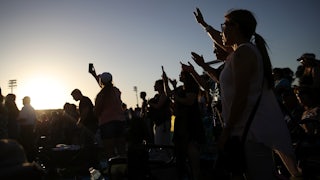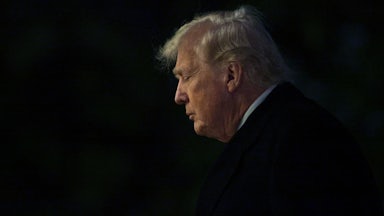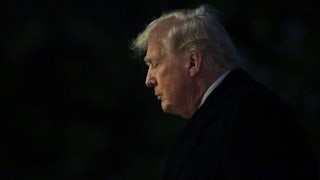“Apocalypse.” “A reality far more evil and systematic than I imagined it could be.” “The scale of malfeasance is truly shocking.” “The largest crisis of institutional religion in the United States.” “Bombshell.”
These are just a few of the words that have been used to describe the recent revelations that the Southern Baptist Convention, or SBC—America’s largest Protestant denomination and a predominantly white one—is not only chock full of sexual abusers, but its leaders have systematically engaged in efforts to cover up these abuses, disparage the victims, and obstruct even modest efforts at reform.
The nearly 300-page report provided by the investigation firm Guidepost Solutions is breathtaking. Based on an eight-month probe solicited by the SBC, it reveals that the organization’s top leaders maintained a secret database of more than 700 abusers, all while telling rank-and-file members of the Southern Baptist flock that such an endeavor was unreasonable and impossible. The investigative report tells of one former SBC vice president who was credibly accused of sexually abusing a 14-year-old, a former president who dragged his feet on reporting child sex abuse allegations out of “heartfelt concern” for the accused, and another former president who failed to report several allegations of abuse against young boys. And this is just the tip of the iceberg.
It’s no wonder that much of the rhetoric emerging from the aforementioned quarters invokes the apocalypse. Yet there is still this pressing feeling that, for all the hyperbole running through the commentary, the core of this scandal is still very much under wraps. Stones have been left unturned, under which the real wormy rot at the center of the SBC continues to fester. What has been excluded from the conversation that has unfolded over the last week? The very thing that’s largely been missing from the broader industrial complex of criticism of white evangelicalism: a clear sense of the racist logic that underwrites patriarchal abuse within white evangelical communities.
With some exceptions, when popular white memoirists narrate stories of how they have found refuge after escaping from the evangelical community’s purity culture (which is rightly understood as the cornerstone of rape culture), they do so without either acknowledging or meaningfully addressing how that culture principally exists to justify white racial violence. Academics tell how complementarianism—the doctrine of “separate but equal” applied to men and women—has roots in secular Victorian gender conventions, but not in eugenics. White critics frame the SBC’s racism as analogous to its misogyny, rather than constitutive of it. And if they do acknowledge that racism enables a culture of abuse, they typically leave to the imagination how it does so.
Unless and until more white evangelicals and their same-colored critics come to grips with how institutional racism gives rise to sexual abuse scandals like the present one, no one can credibly claim that some new era is upon us; both whites and people of color will continue to be victimized within and beyond white evangelical spaces.
The SBC, as many are now reminding, was founded in 1845 to protect the institution of chattel slavery; its leaders proclaimed that such a racial caste system was ordained by God and revealed by scripture. But theology was never the Southern Baptists’ sole means of upholding racial violence. Sexual purity rhetoric was also deployed to protect the status quo, especially in the years following the Civil War.
Reminiscent of the Catholic Church’s centuries-long efforts to cast Jews as a danger to innocent Christian children, white evangelicals in the South fantasized that newly freed Black men had but one thing on their mind: the desire to rape their (white) women. Like the antisemitic conspiracy with preceding origins, this was a blatant projection of the community’s own violent tendencies. Just as it was the church itself that had long persecuted Jews—including by falsely blaming them for Jesus’s death—it was white Christian slaveholders who had earned the notorious reputation for making trails to backyard cabins with sexual violence on their minds. They raped Black women to further emasculate Black men, force Black women into submission, and impregnate those women, thereby increasing the number of people in bondage. But for all its farce, the white evangelical belief that Black men embodied sexual menace flourished.
D.W. Griffith’s 1915 film, The Birth of a Nation, famously depicted a Southern Belle jumping off a cliff to evade a Black man (a white actor in blackface), prompting the Ku Klux Klan to chase down and kill her assailant. Over the next few decades, Klansmen and other racial terrorists lynched thousands of Black men, often on the basis of false accusations or for such offenses as addressing white women with less formality than observers thought proper. As Ida B. Wells reported in the early decades of the century, white society was utterly uninterested in protecting Black women, who were viewed as dirty by nature and who were themselves the victims of lynching. This society was equally uninterested in protecting white women from the predations of white men.
As the century unfolded, white evangelicals continued to brandish the mythical purity of their young women and even their children for the sake of maintaining this pillar of white supremacy, all the while doing nothing to curb sexual violence where experts said it predominantly occurred: in familiar homes, at the hands of familiar people. Sexual and racial purity rhetoric pervaded white evangelicals’ resistance to civil rights and its perceived ally, communism. Dallas preacher Carey Daniel spoke for many when he wrote in his popular 1955 book, God the Original Segregationist, “There is absolutely nothing the Communists would love more than a mongrelized America that they could easily enslave.” It’s hard to miss the projection—the fear that others might come to do to whites what whites had long done to others.
Concurrently, there came a torrent of evangelical marriage manuals infused with sexual purity rhetoric drawn directly from secular eugenics—none more influential than those of psychologist and Focus on the Family founder Dr. James Dobson. As I’ve written elsewhere, Dobson cut his teeth at an institute founded expressly to promote marriage and breeding among able-bodied, middle-class white couples, then baptized this program as “biblical family values.” Just like his racist mentor at the American Institute of Family Relations, Paul Popenoe, he discouraged interracial sex and sowed fear of “violent criminals” coming across the border. The (white) family had to be protected at all costs. Well, up to a point, anyway: Dobson routinely questioned the innocence of domestic abuse victims. He also viewed domestic abuse as insufficient grounds for divorce.
This history continues to haunt evangelical purity culture and post-purity spaces, according to scholars like Sara Moslener, who serves both as a religion professor and the director of the After Purity Project at Central Michigan University. In an interview with The New Republic, Moslener explained how evangelical girls are taught to fear premarital sex. Consequently, when assault or abuse happens they don’t have the wherewithal to recognize it—all sex before marriage is dangerous. They’re also taught to fear men. But as society has pinpointed Black men as the aggressors, they are essentially “being inducted into the logics of lynching.” They come to believe they need to be protected by their fathers, brothers, and other valiant white men—the very people who are most likely to hurt them. Moslener flagged a prime example of this lynching logic in a tweet responding to the SBC scandal, “The answer to abuse in the church is Biblical patriarchy. Real men protect women and guard the church, standing firm on God’s Word as Kingsmen.”
The fact that the SBC pushed its crusade against “critical race theory,” while sitting on knowledge of its own rampant sexual abuse is further suggestive that racial terror is still very much at work within the organization. It’s particularly noteworthy that the SBC began going after CRT well before CRT became the bogeyman du jour, as noted by Robert Downen, part of The Houston Chronicle team whose 2019 report helped to force sexual abuse within the SBC into the spotlight. Within lynching culture, white men can project all of their sins onto the dark-skinned other. One could make the case that the recent scapegoating of LGBTQ+ individuals and public school teachers as groomers and pedophiles is an extension, rather than aberration, of this project, given the threat that both are understood to pose to the virility and interests of white supremacy.
That white stories of abuse are given primacy is also of a piece with the racial terrorism at the roots of SBC traditions. I documented this phenomenon in a previous piece for The New Republic on the so-called deconstruction movement, and Anthea Butler, associate professor of religious studies and Africana studies at the University of Pennsylvania, highlighted it in the context of the unfolding scandal. “You know what I really want to see in the next few months/years?” Butler tweeted. “A similar report on African American denominations and sexual abuse in the church, just like this SBC report.... #notholdingmybreath.” Theologian and preacher Kyle Howard also expressed regret that, “in so many cases, church abuse isn’t a real problem until White people experience it.” Both Butler and Howard have consistently stirred dialogue on racism within evangelicalism, along with ordained minister and theologian Jo Luehmann, host of the Straight White American Jesus podcast Brad Onishi, public historian Jemar Tisby, and author and founder of the Public Religion Research Institute Robert P. Jones.
The superlative language describing the scandal (“apocalypse”) offers a rhetorical case in point of the need for their voices. In an editorial for The Washington Post, and as quoted above, Michael Gerson called the failure to prioritize abused women and children “the largest crisis of institutional religion in the United States.” This is remarkable, considering how relentlessly white Christians continue to subjugate and silence Black bodies in churches, schools, and public life.
Moslener sees the elevation of white women’s interests and voices within both popular and academic conversations as a sign of a resurgence of the white evangelical feminism that cropped up in the nineteenth century. The likes of Frances Willard and other members of the Women’s Christian Temperance Union pitted white women against Black Americans, as if only one group could advance. (White feminism, more broadly, did the same.) That is also what’s happening within the SBC, the scandal coming at a time when Black Southern Baptists are exiting the convention over its continued hostility toward racial justice. The SBC is having to decide whom it wants to sacrifice, says Moslener, and it appears that won’t be white women.
Which is a shame for everyone, including white women. As the history of white evangelicalism vividly shows, the wounds of anti-Black racism run deep and wide. There will never be peace for some individuals while the unwillingness to reckon with the original sins remains the order of the day. This may be hard for many current and former white evangelicals to comprehend, given the intense emphasis on individual salvation. Certainly, given the lies we’ve all been fed, wider white America is likewise struggling to grasp that we really are each other’s keepers. But the more of us who come to find ourselves in the shadow of the rising anti-democratic tide, the more the Reverend Dr. King’s words ring true: “Injustice anywhere is a threat to justice everywhere.”










